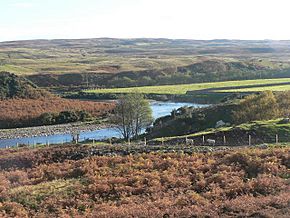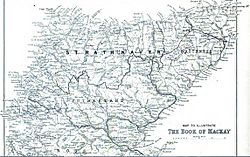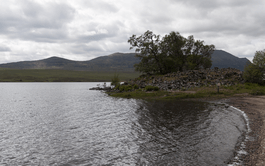Strathnaver facts for kids
Quick facts for kids River Naver |
|
|---|---|

River Naver near Achargary
|
|
| Country | Scotland |
| Physical characteristics | |
| Main source | Loch Naver |
| River mouth | Bettyhill |
| Length | 29 km (18 mi) |

Strathnaver or Strath Naver is a beautiful valley in northern Scotland. It gets its name from the River Naver, a famous river known for its salmon. The river flows from Loch Naver all the way to the sea on the north coast.
Strathnaver is also known as the Mackay Country. This is because the powerful Clan Mackay once controlled this area. Their land covered most of northwest Sutherland.
Contents
Loch Naver is at the top of the valley. It sits near a mountain called Ben Klibreck. The loch is about 10 km (6 mi) long and 33 m (108 ft) deep. People have come to the Altnaharra Hotel by the loch to fish since the early 1800s.
Two rivers, Mudale and Vagastie, and several smaller streams feed into Loch Naver. Just below the loch, the River Naver joins with the River Mallart. The Naver then flows through the Naver Forest. It passes under a bridge at Syre. Other streams like Langdale Burn and Carnachy Burn also join the river. The valley then gets wider and the river flows into the sea at Bettyhill.
Most of Strathnaver is in the area of Farr. This is a village on the coast. The old church there is now the Strathnaver Museum. Today, Strathnaver is part of the Highland Council area.
The name Nabaros was mentioned by an Egyptian writer named Ptolemy in the 2nd century. It was even on his map. The name might come from an old word meaning "cloud."
Scientists have found signs of very old settlements in Strathnaver. These include a "village" from the Neolithic period (New Stone Age). It was found near Bettyhill.
There are also several ancient stone towers called brochs in the valley. One broch by Loch Naver at Grummore is about 2,000 years old.
Early Conflicts
Around the 11th century, a Norwegian family ruled Orkney and Caithness. They tried to take control of Strathnaver. But in the late 1100s, local Scots fought and defeated them. This battle happened at Dalharrold, near Loch Naver.
The Rise of Clan Mackay
After this, the Clan Mackay became very important. In 1408, Angus Dow Mackay gained a lot of power. By 1427, he was a powerful chief. He was even called "Angus the Absolute" because he had so many men under his command.
The Earls of Sutherland often fought with the Mackays for control of Strathnaver. The two families usually took different sides in conflicts. For example, in 1578, the Earl of Sutherland fought the Mackays in a battle near Bettyhill.
By the mid-1600s, the Mackays faced money problems. They tried to keep up with the more powerful Sutherlands. The Sutherlands eventually bought the last of the Mackay lands in Scotland in 1829.
The Highland Clearances
Strathnaver, like many places in the Scottish Highlands, was affected by the Highland Clearances. This was a time when many people were forced to leave their homes. Landowners wanted to create large sheep farms. These farms brought in more money than the small farms that were there before. Another goal was to help with times of famine that often happened in the region.
The people who were moved were offered small plots of land called crofts near the coast. The idea was that they could fish for a living. They could also grow some crops and keep a few animals. But the people felt they lost their status as farmers.
The first clearances in Strathnaver happened in 1814. About 28 families were told to leave. Their homes were destroyed to stop them from moving back in. Sometimes, the roofs were burned.
In 1816, a man named Patrick Sellar, who worked for the Sutherland estate, was put on trial. He was accused of burning houses and other things. He was found not guilty of all charges.
A much larger clearance happened in 1819. This involved about 236 families. The estate was worried about bad publicity after Sellar's trial. But houses were still destroyed by fire. This happened after a dry spell, so the fires were very big. People who saw it were horrified. This time became known as "the year of the burnings." Newspapers even wrote about "the Devastation of Sutherland."
The clearances changed Strathnaver from a farming area to mostly sheep farms. Later, people looked back at the Highland Clearances. In 1897, a group called the Congested Districts Board was created. Their job was to help the crowded crofting communities that had been created. They bought land in Strathnaver and divided it into many new crofts. This created the landscape we see today.
The River Naver is a special place for nature. It is important for Atlantic salmon. It is also home to Freshwater pearl mussels. Long ago, people used to collect pearls from the Naver and Mallart rivers.
The River Naver is well-known for salmon fishing. But the area is also being promoted to other visitors as "Mackay Country."
You can drive along the B873 road on the west side of the valley. It goes from Altnaharra past Loch Naver to Syre. From there, the B871 road continues to the A836 road. These roads connect to the Strathnaver Trail. This trail takes you to many historic sites in the area.


